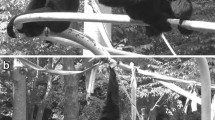Abstract
Many hypotheses have been proposed linking the emergence of lateralized activities—such as handedness—in primates, with hemispheric specialization and the evolution of complex communication such as human language. Although data to test these ideas are rapidly accumulating for many primate taxa, some species are still largely unexplored, especially under natural conditions. I present the first data on a population of wild siamangs (Symphalangus syndactylus), highly arboreal small apes. Preference for the left hand is shown both at the individual and population levels for a complex manual task: collecting and drinking water from tree holes. There was no difference in hand preference between males and females, and immature individuals showed more variable patterns than adults. These results are consistent with the postural origins theory, allow a new interpretation of the findings of comparable studies, and indicate a useful behavior for future investigations of laterality in wild primates.
Similar content being viewed by others
References
Annett, M. (1978). Genetic and nongenetic influences on handedness. Behavior Genetics, 8, 227–249.
Biro, D., Sousa, C., & Matsuzawa, T. (2006). Ontogeny and cultural propagation of tool use by wild chimpanzees at Bossou, Guinea: Case studies in nut cracking and leaf folding. In T. Matsuzawa, M. Tomonaga, & M. Tanaka (Eds.), Cognitive development in chimpanzees (pp. 476–508). Tokyo: Springer.
Boesch, C. (1991). Handedness in wild chimpanzees. International Journal of Primatology, 12, 541–558.
Carpenter, C. R. (1976). Suspensory behavior of gibbon Hylobates lar. In D. M. Rumbaugh (Ed.), Gibbon and siamang (Vol. 4, pp. 1–20). Basel: Karger.
Corballis, M. C. (1983). Human laterality. New York: Academic.
Corballis, M. C. (1989). Laterality and human evolution. Psychological Review, 96, 492–505.
Coren, S., & Porac, C. (1977). Fifty centuries of right-handedness: The historical record. Science, 198, 631–632.
De Vleeschouwer, K., Van Elsacker, L., & Verheyen, R. F. (1995). Effect of posture on hand preferences during experimental food reaching in bonobos (Pan paniscus). Journal of Comparative Psychology, 109, 203–207.
Fagot, J., & Vauclair, J. (1991). Manual laterality in nonhuman primates: A distinction between handedness and manual specialization. Psychological Bulletin, 109, 76–89.
Forsythe, C., Milliken, G. W., Stafford, D. K., & Ward, J. P. (1988). Posturally related variations in the hand preferences of the ruffed lemur (Varecia variegata variegata). Journal of Comparative Psychology, 102, 248–250.
Frost, G. T. (1980). Tool behavior and the origins of laterality. Journal of Human Evolution, 9, 447–459.
Goodman, M., Grossman, L. I., & Wildman, D. E. (2005). Moving primate genomics beyond the chimpanzee genome. TREE, 21, 511–517.
Heedstand, J. E. (1985). Behavioral lateralization in four species of apes? Doctoral dissertation. Seattle: University of Washington.
Hopkins, W. D., Stoinski, T. S., Lukas, K. E., Ross, S. R., & Wesley, M. J. (2003). Comparative assessment of handedness for a coordinated bimanual task in chimpanzees (Pan troglodytes), gorillas (Gorilla gorilla), and orangutans (Pongo pygmaeus). Journal of Comparative Psychology, 117, 302–308.
Hopkins, W. D., Russell, J. L., Remkus, M., Freeman, H., & Schapiro, S. J. (2007). Handedness and grooming in Pan troglodytes: Comparative analysis between findings in captive and wild individuals. International Journal of Primatology, 28, 1315–1326.
Lehman, R. A. W. (1993). Manual preference in prosimians, monkeys and apes. In J. P. Ward & W. D. Hopkins (Eds.), Primate laterality: Current behavioral evidence of primate asymmetries (pp. 149–181). New York: Springer.
Lonsdorf, E. V., & Hopkins, W. D. (2005). Wild chimpanzees show population-level handedness for tool use. PNAS, 102(35), 12634–12638.
MacNeilage, P. F., Studdert-Kennedy, M. G., & Lindblom, B. (1987). Primate handedness reconsidered. Behavioral Brain Sciences, 10, 247–303.
Marchant, L. F., & McGrew, W. C. (2007). Ant fishing in chimpanzee is not lateralised. Primates, 48, 22–26.
McGrew, W. C., & Marchant, L. F. (1997). On the other hand: Current issues in and meta-analysis of the behavioral laterality of hand function in nonhuman primates. Yearbook of Physical Anthropology, 40, 201–232.
McManus, C. (2002). Right hand, left hand: The origins of asymmetry in brains, bodies, atoms, and cultures. Cambridge, MA: Harvard University Press.
Olson, D. A., Ellis, J. E., & Nadler, R. D. (1990). Hand preferences in captive gorillas, orang-utans and gibbons. American Journal of Primatology, 20, 83–94.
Panger, M. (1998). Hand preference in free-ranging white-throated capuchins (Cebus capuchinus) in Costa Rica. International Journal of Primatology, 19, 133–163.
Papademetriou, E., Sheu, C., & Michel, G. F. (2005). A meta-analysis of primate hand preferences, particularly for reaching. Journal of Comparative Psychology, 119, 33–48.
Peters, H. H., & Rogers, L. J. (2008). Limb use and preferences in wild orang-utans during feeding and locomotor behavior. American Journal of Primatology, 70, 261–270.
Redmond, J. C., & Lamperez, A. (2004). Leading limb preference during brachiation in the gibbon family member, Hylobates syndactylus (siamangs): A study of the effects of singing on lateralisation. Laterality, 9, 381–396.
Spinozzi, G., & Truppa, V. (1999). Hand preferences in different tasks by tufted capuchins (Cebus apella). International Journal of Primatology, 20, 827–849.
Stafford, D. K., Milliken, G. W., & Ward, J. P. (1990). Lateral bias in feeding and brachiation in Hylobates. Primates, 31, 407–414.
Acknowledgments
I thank Susan Cachel for introducing me to this fascinating field, and Martha K. Holder, Joanna Setchell, and William Hopkins for helpful and insightful comments to the manuscript. I thank Claudia Barelli, Laura Muniz, Montserrat Soler, Emily Aronoff, and Ryne Palombit for valuable suggestions and my research assistants Laji, Tarmin, Usman, Maryadi, Mislan, and Budi for their expert, enthusiastic, and professional collaboration in the jungle. I gratefully acknowledge the National Science Foundation (Grant ID 0726022) and Wenner-Gren Foundation (Grant 7766) for funding my research project, and the State Ministry of Research and Technology and Forestry Department of Indonesia for permission to conduct research in Sumatra.
Author information
Authors and Affiliations
Corresponding author
Rights and permissions
About this article
Cite this article
Morino, L. Left-hand Preference for a Complex Manual Task in a Population of Wild Siamangs (Symphalangus syndactylus). Int J Primatol 32, 793–800 (2011). https://doi.org/10.1007/s10764-011-9501-3
Received:
Accepted:
Published:
Issue Date:
DOI: https://doi.org/10.1007/s10764-011-9501-3




